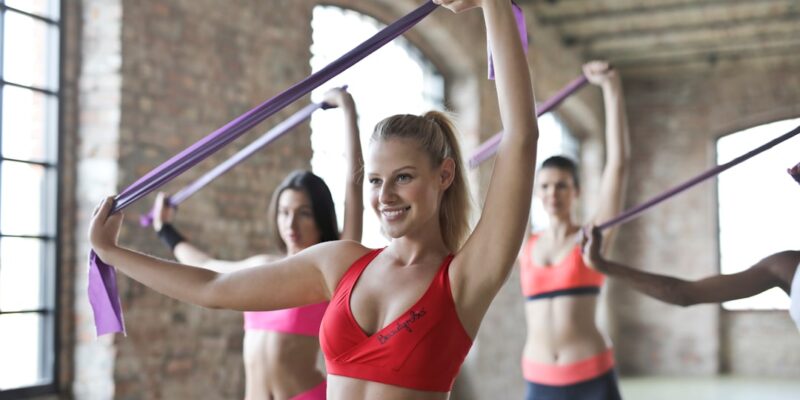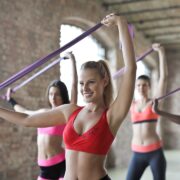
Zumba: Fun and Fitness in One Workout!
Zumba has taken the fitness world by storm, captivating people of all ages and fitness levels with its high-energy dance workouts. This article will delve into the world of Zumba, exploring its origins, benefits, and how it has evolved over time. We will also discuss how to get started with Zumba, adapt the workout to your needs, and the social aspect of this popular exercise. Additionally, we will explore the role of music in Zumba, its stress-relieving benefits, and its potential for weight loss and toning. Whether you’re a seasoned Zumba enthusiast or someone who’s never tried it before, this article will provide you with a comprehensive understanding of this exciting fitness phenomenon.
Key Takeaways
- Zumba is a dance fitness program that combines Latin and international music with dance moves.
- Zumba was created in the 1990s by Colombian dancer and choreographer Alberto “Beto” Perez.
- Zumba can improve physical health by increasing cardiovascular endurance, muscular strength, and flexibility, and mental well-being by reducing stress and boosting mood.
- To get started with Zumba, find a class at a local gym or community center and wear comfortable workout clothes and supportive shoes.
- Zumba can be adapted to all ages and fitness levels, and can be a social activity that builds community through dance.
What is Zumba and how does it work?
Zumba is a dance fitness program that combines Latin and international music with dance moves to create a fun and effective workout. It was created in the 1990s by Alberto “Beto” Perez, a Colombian dancer and choreographer. The workout format typically consists of a series of choreographed dance routines set to upbeat music. Participants follow along with the instructor’s moves, incorporating elements of salsa, merengue, cumbia, reggaeton, and other dance styles.
The beauty of Zumba lies in its simplicity and accessibility. You don’t need any prior dance experience to participate; all you need is a willingness to move and have fun. The routines are designed to be easy to follow, with repetitive steps that allow participants to focus on enjoying the music and getting their heart rate up. Zumba classes typically last for about an hour and can burn anywhere from 400 to 800 calories per session.
In addition to being a great cardiovascular workout, Zumba also offers numerous benefits for overall health and well-being. It can improve cardiovascular endurance, increase strength and flexibility, boost mood, reduce stress, and even aid in weight loss. The combination of dance and exercise makes Zumba a unique and enjoyable way to stay fit.
The history and evolution of Zumba
Zumba was created by Beto Perez in the mid-1990s when he forgot his traditional aerobics music for a class he was teaching. He improvised by using his personal collection of Latin music, and thus, Zumba was born. The workout gained popularity in Colombia before spreading to the United States and eventually becoming a global phenomenon.
Over the years, Zumba has evolved and expanded to include various styles and formats. In addition to the original Zumba Fitness class, there are now specialized classes such as Zumba Toning, which incorporates light weights for added resistance, and Aqua Zumba, which takes place in a pool for a low-impact workout. There are also Zumba classes designed specifically for kids, older adults, and people with physical limitations.
Zumba has also embraced technology, with the introduction of ZIN Jam sessions where instructors can learn new choreography and share ideas online. The Zumba brand has grown to include clothing, accessories, and even video games. Despite its evolution, the core principles of Zumba remain the same: to provide a fun and effective workout that combines dance and fitness.
The benefits of Zumba for physical health and mental well-being
| Benefits of Zumba | Physical Health | Mental Well-being |
|---|---|---|
| Improves cardiovascular health | ✓ | ✓ |
| Increases endurance and stamina | ✓ | ✓ |
| Helps with weight loss | ✓ | ✓ |
| Strengthens muscles and bones | ✓ | ✓ |
| Reduces stress and anxiety | ✓ | |
| Boosts self-confidence and self-esteem | ✓ | |
| Improves mood and overall well-being | ✓ |
Zumba offers numerous benefits for physical health and mental well-being. From a physical standpoint, it is a great way to improve cardiovascular health. The high-energy dance moves get your heart rate up, increasing blood flow and oxygen delivery to your muscles. This can lead to improved endurance and stamina over time.
In addition to cardiovascular benefits, Zumba also helps to improve strength and flexibility. Many of the dance moves in Zumba require you to engage your core muscles, leading to improved abdominal strength. The repetitive nature of the routines also helps to increase muscular endurance in your legs and arms. Furthermore, the dance moves in Zumba require a wide range of motion, which can help to improve flexibility over time.
From a mental health perspective, Zumba can be a great stress reliever. The combination of music, movement, and social interaction can help to distract your mind from daily worries and reduce anxiety. The release of endorphins during exercise can also boost your mood and leave you feeling happier and more energized.
How to get started with Zumba: finding a class and choosing the right gear
If you’re interested in trying Zumba, the first step is to find a class in your area. Many gyms and fitness studios offer Zumba classes, so start by checking their schedules. You can also search online for Zumba instructors or classes near you. Once you’ve found a class that fits your schedule, it’s time to prepare for your first Zumba experience.
When it comes to gear, the most important thing is to wear comfortable clothing that allows for ease of movement. Opt for breathable fabrics that wick away sweat and choose shoes that provide good support and cushioning. Cross-training shoes or dance sneakers are ideal for Zumba as they offer the necessary flexibility and grip.
Before your first class, it’s a good idea to arrive a few minutes early to introduce yourself to the instructor and let them know it’s your first time. They can provide guidance on proper form and modifications if needed. It’s also important to listen to your body during the class and take breaks as needed. Don’t push yourself too hard in the beginning; it’s better to start slowly and gradually increase intensity as you become more comfortable with the movements.
Zumba for all ages and fitness levels: adapting the workout to your needs
One of the great things about Zumba is that it can be modified to suit different age groups and fitness levels. Whether you’re a teenager or a senior citizen, there is a Zumba class that can accommodate your needs. Zumba Kids classes are designed specifically for children, incorporating age-appropriate music and movements. These classes focus on improving coordination, balance, and self-confidence in a fun and engaging way.
For older adults, Zumba Gold classes are available, which offer a lower-impact workout with modified movements. These classes are designed to be gentle on the joints while still providing a fun and effective workout. Zumba Gold Toning classes also incorporate light weights for added resistance.
If you have physical limitations or injuries, it’s important to communicate with your instructor before class so they can provide modifications or alternative movements. They may be able to suggest specific exercises or routines that can be adapted to your needs. It’s always better to err on the side of caution and listen to your body during the workout.
In addition to specialized classes, there are also different types of Zumba classes available that cater to different fitness levels. Zumba Fitness classes are suitable for beginners and those looking for a moderate-intensity workout. Zumba Strong classes, on the other hand, are more intense and focus on high-intensity interval training (HIIT) for maximum calorie burn.
Zumba as a social activity: making friends and building community through dance
One of the unique aspects of Zumba is its social nature. Unlike traditional workouts where you may be focused solely on yourself, Zumba encourages interaction and connection with others. The group setting of a Zumba class creates a sense of camaraderie and support that can make exercise more enjoyable.
Zumba classes often attract people from all walks of life, creating a diverse and inclusive community. This can be especially beneficial for those who may feel intimidated or self-conscious in other fitness environments. The shared experience of dancing and sweating together can break down barriers and foster friendships.
In addition to regular classes, there are also Zumba events and gatherings that bring the community together. These can include Zumba parties, charity events, or even Zumba cruises. These events provide an opportunity to meet new people, dance to live music, and celebrate the joy of movement.
The role of music in Zumba: how it enhances the workout experience
Music is an integral part of the Zumba experience. It sets the tone for the workout and creates a fun and energetic atmosphere. The music used in Zumba classes is carefully selected to match the dance style and tempo of each routine. It includes a mix of Latin rhythms, international beats, and popular songs that are sure to get you moving.
The use of music in Zumba serves several purposes. First and foremost, it provides motivation and inspiration during the workout. The catchy beats and infectious melodies can help to keep you engaged and energized throughout the class. The rhythm of the music also helps to guide your movements, making it easier to follow along with the instructor.
In addition to its practical benefits, music also has a psychological impact during exercise. It can enhance mood, reduce perceived exertion, and increase enjoyment. The combination of music and movement in Zumba creates a multisensory experience that can be both uplifting and empowering.
Zumba as a stress-reliever: reducing anxiety and boosting mood with dance
Exercise has long been recognized as a powerful tool for stress relief, and Zumba is no exception. The combination of dance, music, and social interaction can help to distract your mind from daily worries and reduce anxiety. The release of endorphins during exercise also contributes to a sense of well-being and relaxation.
Zumba provides an outlet for self-expression and creativity, allowing you to let go of stress and tension through movement. The rhythmic nature of the dance routines can be meditative, helping to quiet the mind and promote mindfulness. By focusing on the present moment and the joy of dancing, you can temporarily escape from the pressures of everyday life.
In addition to its stress-relieving benefits, Zumba can also boost mood and enhance self-confidence. The combination of music and movement releases feel-good neurotransmitters in the brain, such as dopamine and serotonin, which can improve mood and reduce symptoms of depression. The social aspect of Zumba can also provide a sense of belonging and support, further enhancing mental well-being.
Zumba and weight loss: how it can help you shed pounds and tone your body
If weight loss is one of your goals, Zumba can be an effective form of exercise to incorporate into your fitness routine. The high-energy dance moves in Zumba can burn a significant number of calories, helping you create a calorie deficit necessary for weight loss. The exact number of calories burned will depend on factors such as your weight, intensity level, and duration of the workout.
On average, a one-hour Zumba class can burn anywhere from 400 to 800 calories. This calorie burn can be further increased by incorporating higher-intensity movements or attending more frequent classes. However, it’s important to note that weight loss is not solely dependent on exercise; a balanced diet and overall lifestyle changes are also crucial.
In addition to its calorie-burning potential, Zumba can also help to tone and sculpt your body. The dance moves in Zumba engage multiple muscle groups, including your core, legs, and arms. Over time, this can lead to increased muscle definition and improved overall body composition.
Zumba as a lifelong pursuit: maintaining fitness and having fun with dance for years to come
One of the great things about Zumba is that it can be a lifelong pursuit. Whether you’re in your teens or your golden years, there is a Zumba class that can accommodate your needs and fitness level. The dance routines can be modified to suit different age groups and physical abilities, making it a sustainable form of exercise.
As you age, your fitness goals and abilities may change, and Zumba can adapt to those changes. There are specialized classes for older adults, such as Zumba Gold, which offer a lower-impact workout with modified movements. These classes can help to maintain strength, flexibility, and balance as you age.
Zumba can also be adapted to changing fitness levels and goals. As you become more comfortable with the movements, you can increase the intensity or try different types of Zumba classes. For example, if you’re looking for a more challenging workout, you can try Zumba Strong, which incorporates high-intensity interval training (HIIT) for maximum calorie burn.
Furthermore, Zumba is a fun and enjoyable way to stay active for years to come. The combination of dance, music, and social interaction makes it an engaging and entertaining form of exercise. Unlike traditional workouts that may feel like a chore, Zumba feels more like a party. This makes it easier to stick with and maintain a consistent fitness routine.
Zumba has become a global phenomenon for good reason. It offers a fun and effective way to stay fit while enjoying the benefits of dance and music. Whether you’re looking to improve cardiovascular health, increase strength and flexibility, reduce stress, or lose weight, Zumba has something to offer.
The social aspect of Zumba is also a major draw for many people. The sense of community and support that comes from dancing and sweating together can make exercise more enjoyable and sustainable. Zumba events and gatherings provide an opportunity to meet new people, celebrate movement, and have fun.
So why not give Zumba a try? Whether you’re a seasoned dancer or someone who’s never set foot in a dance studio before, there is a Zumba class that can accommodate your needs. So put on your dancing shoes, turn up the music, and let the rhythm move you. You may just discover a new passion and a whole new way to stay fit and have fun.
FAQs
What is Zumba?
Zumba is a dance fitness program that combines Latin and international music with dance moves. It was created in the 1990s by Colombian dancer and choreographer Alberto “Beto” Perez.
What are the benefits of Zumba?
Zumba is a fun and effective way to improve cardiovascular health, burn calories, and tone muscles. It can also improve coordination, balance, and flexibility.
Is Zumba suitable for beginners?
Yes, Zumba is suitable for beginners as well as advanced exercisers. The dance moves can be modified to suit different fitness levels and abilities.
What should I wear to a Zumba class?
Wear comfortable workout clothes and supportive athletic shoes. Avoid loose clothing that may get in the way during the dance moves.
Do I need any equipment for Zumba?
No, you do not need any equipment for Zumba. Just bring a water bottle and a towel to wipe off sweat.
How long is a typical Zumba class?
A typical Zumba class is usually 60 minutes long, but some classes may be shorter or longer.
Can Zumba help me lose weight?
Yes, Zumba can help you lose weight by burning calories and increasing your metabolism. However, weight loss also depends on your diet and overall lifestyle habits.
Is Zumba safe for people with injuries or health conditions?
It depends on the injury or health condition. It is recommended to consult with a doctor before starting any new exercise program, including Zumba. The dance moves can be modified to accommodate different injuries and health conditions.


















